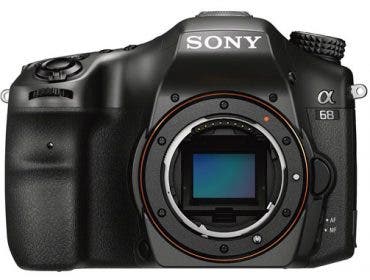Can this feature actually improve your people pictures? Here’s the surprising answer!
Let’s face it: People are by far the most popular photographic subjects, and they all have faces. Shooting a frame-filling close-up of a toddler eating spaghetti doesn’t usually pose much of a technical problem for the autofocus (AF) and autoexposure (AE) systems built into today’s compact digital cameras–they’ll focus on her face and generally give you an excellent exposure. But when you place that toddler’s face off-center near the edge of the frame, compose a double portrait of mom and dad, or photograph a group of people sitting around the dinner table, things start getting interesting.
Conventional AF systems, even those with multiple AF zones, will sometimes miss the faces and focus on something else that’s between them, farther away, or closer. The result: The people in your picture will be out of focus, blurry, and over- or underexposed–not a good thing.

With Face Detection turned on, face detection identifies main face (green frame) and subsidiary faces (white frames) and calculates optimum focus and exposure. System prioritizes faces closest to center of frame. Number of faces recognized in a scene varies depending on which camera you are using. Photo courtesy Fujifilm USA.
Sure, you can use your brain, lock focus on your intended subject by holding in the shutter button partway, recomposing, and shooting. But in the excitement of the moment, it’s easy to forget. And even though it only takes a moment to autofocus the intelligent way, in that brief instant little Rachel’s perfect expression can well have vanished.
Fortunately, camera manufacturers have addressed this sticky problem literally head-on, and have come up with ingenious solutions known as Face Recognition, Face Detection, or Face Priority Mode. Some variation of face detection can be found on almost every compact digital camera, EVF, mirrorless interchangeable-lens compacts that is being made today.
Basically, face identification is a form of pattern recognition–when you turn on the camera’s face-detection system, the AF and AE systems analyze the objects appearing within the borders of the frame, and compare them with algorithms stored in the camera’s electronic memory. When face patterns are detected (up to 10 in some systems, fewer in others), the camera focuses on your intended subjects, and exposes the subjects properly.

Here’s how face detection looks when using a typical Nikon compact digital camera. Photo courtesy Nikon USA.
Not all face detection systems work exactly the same way when it comes to identifying and prioritizing multiple faces within a frame, but all provide some kind of readout on the LCD–usually a frame around the prioritized face–to let you know what the camera is focusing on so you can override its decision if you disagree. Some systems can be turned off when you’re photographing subjects other than people, such as landscapes or pets. Others are on all the time, the manufacturers claiming that their systems can tell with a high degree of certainty when there are faces in the picture.
No face detection systems can perform miracles of course, such as simultaneously achieving a sharp, perfectly exposed image of uncle Fred who is 27 feet away and cousin Charlie whose face is three feet from the camera. However, based on my hands-on experience with Fujifilm. Canon and Nikon cameras incorporating face recognition systems, they do a remarkably good job well over 90 percent of the time, and they have the great advantage of doing so automatically without time-consuming user intervention.
The only thing you have to remember with face detection is that the operational procedure varies with the camera. If your camera has user-selectable face recognition system, you’ve got to turn it on when you’re taking people pictures and turn it off when you’re shooting, say, scenic vistas or close-ups of flowers. This is usually a simple procedure–push the button to turn the system on and a face detection icon appears on the LCD.
What happens if you don’t turn off face detection when shooting, say, landscapes? Based on my field tests, it seldom causes any focusing or exposure errors. The theory is that something like a face-shaped object in the foreground could mess things up, but this is a highly unlikely scenario.
However, face detection systems will focus on photographs and paintings of faces as well as statues, etc. appearing in your pictures. They will not focus on dog, cat, and cow faces–apparently they are sophisticated enough to differentiate human from animal faces, and some manufacturers claim their systems can even pick out faces that are in profile or three-quarter view as well as those facing the camera.
Using face detection: A hands-on example
While it’s not possible to provide a detailed comparison of the specific performance characteristics of each manufacturer’s face recognition system or the slightly different iterations among the various camera models in one concise article, here’s a hands-on example of how it works using a typical 2007 point and shoot digital camera–the 8.3 megapixel Fuji FinePix F40fd (yes, the last two italicized letters stand for face detection).
 Off-center magic: With face detection turned on camera focuses properly on off-center face (above), but with system turned off (below) sharpest focus is on background details in window on left, and face is less sharp. Photos: Jason Schneider Off-center magic: With face detection turned on camera focuses properly on off-center face (above), but with system turned off (below) sharpest focus is on background details in window on left, and face is less sharp. Photos: Jason Schneider |
To enable face detection, turn the camera on, press the face detection button on the back of the camera once (it has an icon of a person showing the head in autofocus brackets), push lightly on the shutter release and an identical icon appears in the upper left-hand corner of the 2-1/2-inch LCD confirming that the system is activated.
If you point the camera at a person or a group of people, a green frame will appear over the primary subject and a white frame may appear over subsidiary subjects. If you take the picture, the primary subject will be sharply focused and well exposed, and the subsidiary subject or subjects will be as sharply focused and well exposed as possible given their varying distances from the camera, their relative brightness, and whether they’re within the range of the built-in flash.
As previously mentioned, the system works very well in most cases, and you are unlikely to improve the result by manual intervention, but it can’t perform miracles, such as extending depth of field or flash range beyond the laws of physics. If you’re shooting a single subject, such as an off-center portrait, the green frame will appear over the subject’s face (it varies in size to match the facial outline) and the camera will focus on the face, not on distant objects in the center of the frame.
 Watching the detection: With face detection turned on (above) camera identifies and focuses on woman closest to camera, and man in the distance is less sharp. With face detection turned off (below), central AF zone of camera focuses on man in the distance and woman in foreground is slightly less sharp. Photos: Jason Schneider Watching the detection: With face detection turned on (above) camera identifies and focuses on woman closest to camera, and man in the distance is less sharp. With face detection turned off (below), central AF zone of camera focuses on man in the distance and woman in foreground is slightly less sharp. Photos: Jason Schneider |
The exposure will also favor the face, giving good skin tones, though the background may be under- or overexposed depending on its brightness, distance from the camera, etc. The Fuji F40fd also performs well when shooting a double portrait, and will almost always display a green frame over one of the subjects rather than focusing on, say, the distant tree in the middle of the frame. And occasionally, perhaps 2 to 3 percent of the time (especially with faces that are shadowed, in profile, wearing strange hats or scarves etc.) the face detection system will either fail to identify a face or put a frame around something other than a face.
The remedy in such cases is simple–turn off face detection by pressing the face detection button (you’ll be prompted by a big “face detection off” icon in the center of the LCD) press the shutter button lightly to turn the system off, lock focus on the subject you select, recompose, and take the picture.
The face of the present and future
When Face Detection was first introduced in 2007, it became an instant hit because it worked. Since then, it has been fine-tuned. While the first generation of cameras with Face Detection could identify up to six faces per frame, newer models could recognize 8, 10, even 16 faces per image. Some cameras will even let you tag specific faces (add a name to a face) and the camera could then sift through other images on your memory card, searching for the same faces and tagging them automatically. When you take more pictures, the camera can automatically recognize certain faces and prioritize exposure and focus for them over others in the scene. There’s even a “face detection self-timer” mode on a few models: with the camera on a tripod, press the shutter release and the camera will wait for you to step into the picture, then wait 2 more seconds before shooting.
Every year, it seems more refinements are added to Face Detection. As when it was introduced, Face Detection is a fine example of how cutting-edge technology can help improve the quality of your photographs.


